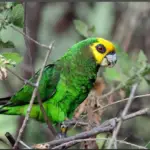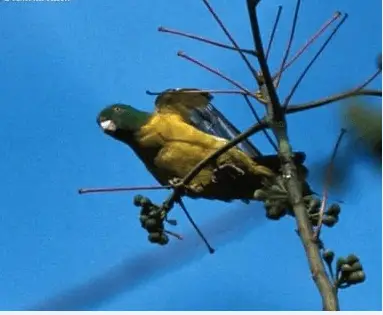Blue-winged Racquet-tail Parrot 28–30 cm, plus racquets of 5–6 cm. Green parrot with racquet-like tail extensions, bright blue-green head, sky-blue crown, and whitish-grey or bluish-grey bill, becoming palest at tip; iris pale yellow to brown; legs grey.
Male Blue-winged Racquet-tail Parrot has a large red spot in the center of the crown, underparts and collars more yellowish-green, darker green on wings and head, with a bluish wash to inner and outer webs of all primaries, outer tail feathers tipped black and tail spatules also blackish.
Most likely to be confused with two sympatric Tanygnathus parrots (T. sumatranus and T. lucionensis), but smaller, appearing shorter-tailed (except racquets, which can be difficult to see) and has pale (not red) bill (female T sumatranus also has a white bill, but it is much larger).
Similar to wholly allopatric P. montanus but forehead, sides of the head, and nape green. Female like female montanus but with no (or very little) blue on the face (or red spot on crown). Immature is like female but lacks or has only short spatules.
Systematics History
Part of the P. discurus clade (see below). Was previously thought possibly to belong to a group containing P. waterstradti, P. montanus and P. platenae. Sometimes still treated as conspecific with P. montanus, but case recently made for species status. Monotypic.
Distribution
The Sulu Archipelago, in SW Philippines. Possibly persists only on Tawitawi; at least historically, found also on smaller islands of Tumindao (no recent records), Sibutu, Manuk Manka (no recent records), Bongao (considered probably extinct), and Sanga-Sanga (probably extinct).
Habitat
Primary lowland forest Blue-winged Racquet-tail Parrot, including mangroves, forest edge adjacent to cleared and agricultural areas.
Sounds and Vocal Behavior
Vocalizations similarly varied to other Prioniturus, including harsh rasping “aaaaack” notes, or trumpeting lee-aaack with emphasis on the second syllable. Considered to be most vocal in flight.
Breeding
Sept–Jan. Nest recorded in a large broken-off palm tree in a grove of palms close to the forest.
Personality
The body length is 31 cm, the wing length is 163 mm to 185 mm. Basic plumage, sides of head and neck are green. In the male, the crown is dull light blue with a large red spot. The breast and abdomen are distinctly yellow-green.
The undersides of the wings and tail are green-blue. The two middle tail feathers have elongated, spatulate, blackish-blue plumes. The green outer tail feathers are tipped.
A narrow, featherless, gray ring runs around the eyes. The beak is bluish horn-colored with a whitish tip. The iris is dark brown. The feet are blue-grey.
The female Blue-winged Racquet-tail Parrot is all green with a faint blue tinge on the crown. The tail is shorter on average, the beak is lighter. The young birds resemble the females. However, they lack spatulate plumes.
Way of life
The Blue-winged Racquet-tail Parrot usually forages singly, in pairs, or in small flocks. In-flight it is noisy and conspicuous. It is well camouflaged in the foliage of the trees and is difficult to spot.
In fruiting trees, it associates with other species of parrots or pigeons. In the trees, it is active but silent. The powerful flight is fast with deliberate wing beats. Occasionally you can see it on bright moonlit nights.
Diet
Blue-winged Racquet-tail Parrot diet includes fruits, seeds, nuts, berries, rice, and flowers. Little is known about breeding biology. breeding season is between September and January. A nest has been documented in a large broken palm tree in a palm grove near a forest.
Conservation Status
The Blue-winged Racquet-tail Parrot is classified as Critically Endangered by the IUCN) classified. The population was estimated at 50 to 249 mature individuals in 2012.
Although still common in the early 20th century, the population declined sharply until the 1970s. Few specimens were observed at three sites in Tawi-Tawi in 1991, with only six documented in August 1994.
The species was not seen during a search in January 1995. At a survey in 2010 there was only one bioacoustic recording and in 2012 three specimens could be observed. Surveys by field ornithologists are difficult as they are hampered by safety restrictions.
There have been no reports from Bongao, Tumindao, or Manuk Manka for at least 90 years, so the species may already be extinct on those islands.
In Sanga-Sanga there is a little forest area so survival on this island is considered unlikely. In 1981, the Sulu spatula-tailed parrot was included in Appendix II of the Washington Convention on Endangered Species.





















